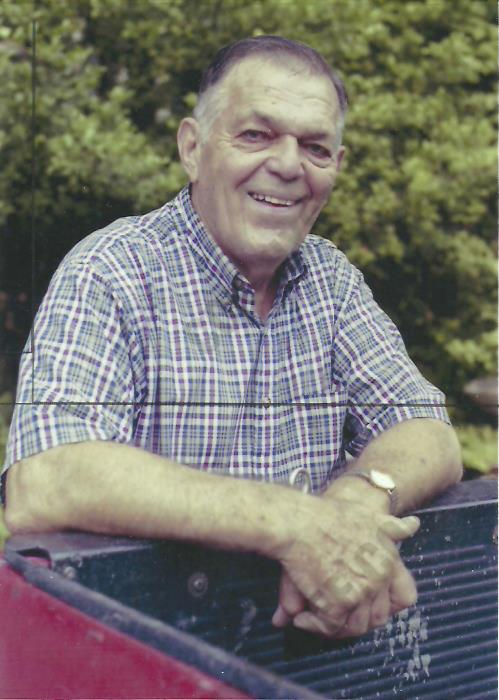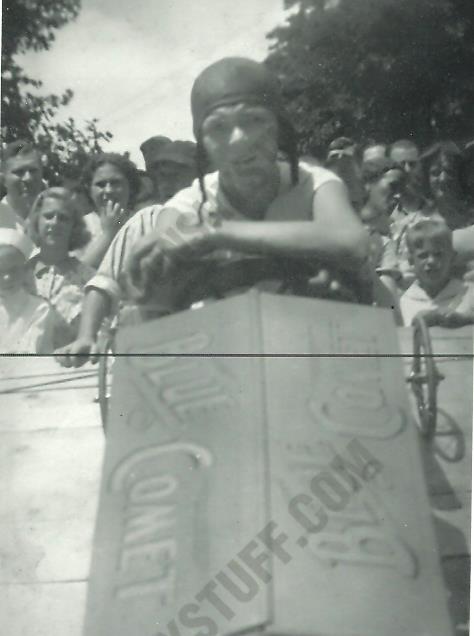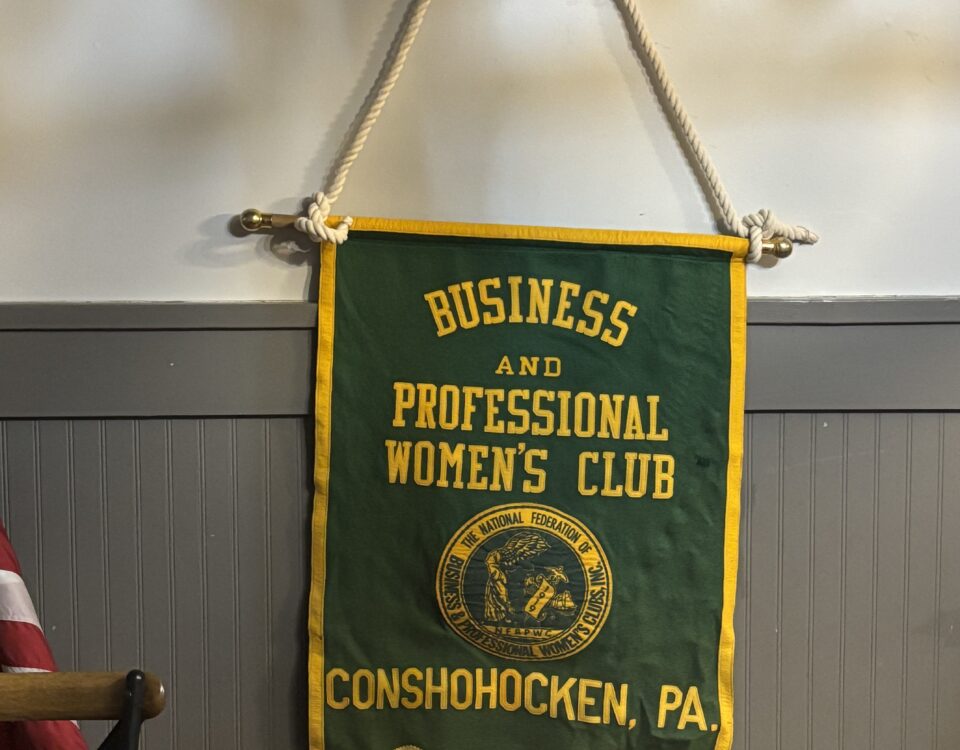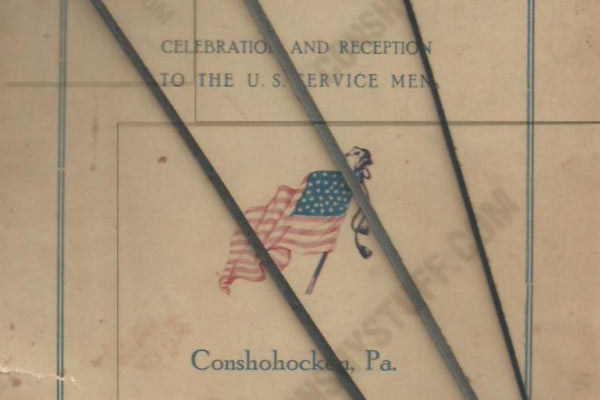
Independence Day; Conshohocken Style by Jack Coll
July 1, 2014Pudge’s in Conshohocken – By Jack Coll
July 16, 2014Conshohocken Soap Box Derby, In The Beginning
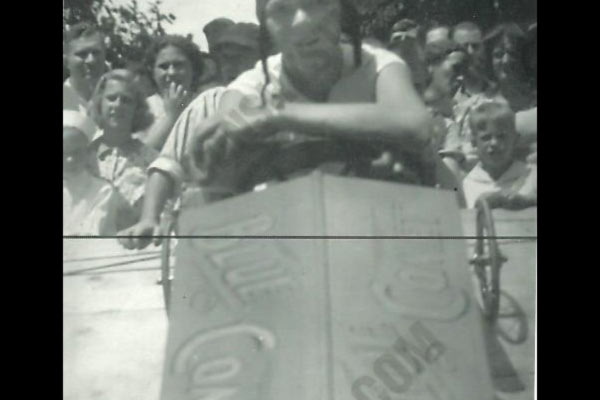
Seventy Six Years Ago This Friday
Walt Cherry, You Were The Man
Conshohocken Soap Box Derby, In The Beginning
By Jack Coll
July 3, 2014
It was 9:00 a. m. at Mary Wood Park, more than a thousand residents attended the flag raising ceremonies officially opening the summer playgrounds. A brief patriotic program sponsored by the Conshohocken Recreation Council, who sponsored both summer playgrounds, was held and Robert C. Landis, Superintendent of Conshohocken’s schools was the principal speaker. Burgess John D. Hampton and Councilman Francis L. Freas also said a few words, Rev. G. E. McCarney of St. Mark’s Lutheran Church offered a prayer and members of the Boy Scouts and Girl Scouts hoisted Old Glory.
It was the morning of July 4, 1938, there were clear summer skies with temperatures expected to reach 90 degrees. The 9:00 a. m. weather was cool with a slight breeze, just enough to move the leaves on the trees that provided shade to everyone standing at the corner of Sixth Avenue and Hallowell Street. The country was climbing out of the worst depression this country had ever seen, and Conshohocken was unaware of war clouds looming overseas.
With the Country’s Great Depression becoming more and more of a memory with each passing day, businesses throughout the borough grew stronger and stronger, believe it or not Flocco’s Shoe Repair Shop located at 103 Fayette Street, next to Taylor’s News Agency, ran weekly specials that included
Men’s Half Soles And Heels…………70 cents & up
Men’s Full Soles And Heels………………$1.45 & up
Ladies Half Soles And Heels…………65 cents & up
School Children’s Shoes Soles And Heels……65 cents & up
Hats Cleaned And Blocked…………………….35 cents
All Shoes Shined For Free
The Paper Store once located at 121 Ford Street in West Conshohocken announced their summer specials including “WHITE ACE SHOE POLISH……BOTTLE—14 cents.”
Not a lot of Americans could afford automobiles in 1938 but if you needed one repaired you could stop at Fred Knoeller’s Official Inspection Station at 117 West Eighth Avenue. Unless you were a regular at Tancini’s Corner once located at the corner of Spring Mill Avenue and Walnut Street, a funny thing is their ad in the Conshohocken Recorder showed two people riding a bike, with the heading RIDE A BIKE, FOR FUN, FOR HEALTH, FOR SPORT, Tancini’s my friends were way ahead of their time with the health kick. Jim McDade’s Auto Service located at 110 East Hector Street was a great stop for many residents back in 1938 as was Bill Branch Purol Service Station once located at 12th Avenue and Fayette Street. Bill would wash your car for 75 cents and grease it for another 50 cents. There was Coder’s joint once located at North Lane and Butler Pike, the current site of Kevin Bowe’s Exxon, you had Moore’s Garage up at 12th Avenue, J. Warrell Auto Accessories at 23 Fayette Street, and of course the John Brothers at Second Avenue and Fayette Street, I think the John Brothers are currently on their sixth or seventh generation of mechanics, the John boys are born with wrenches in their hands, you might want to check them out.
In 1938 things were so good in Conshy, everybody worked, and no one was unemployed. The avenues were sprinkled with corner grocery stores like the Liberty Stores owned and operated by the Cardamone’s at 900 Maple Street, the Nanaszko’s who ran their store at 314 East Elm Street, and the D’Allesandro’s who operated at Sixth Avenue and Maple Street. There was Wilkinson’s Meat Market at 72 Fayette Street, Smith’s Nor-Mont Food Store had just opened at the other end of Fayette Street at 1109, Hillsdale Farm always offered fresh goods once located at 13 East Hector Street, and let’s not forget if you were just hungry for a steak sandwich there was Wally’s Grill at the corner of Sixth Avenue and Wells Street.
In 1938, the John F. DeHaven Post No. 129 American Legion decided to sponsor a soap box derby race
to be held in the borough. At that time soap box derby races held throughout the country were sponsored by the Chevrolet Corporation of America. E. Francis Moore, the local Chevrolet dealer cooperated in every way possible with the members of the John F. DeHaven Post committee to bring the very first soap box derby race to Conshohocken.
More than 75 boys signed up to enter cars in the race, (sorry, no-girls allowed, besides girls could never win a soap box derby race) The only cars that qualified for prizes were cars built to the rules and regulations specifications handed out to each racer, the winner, with a legal car would move on to race in the Philadelphia elimination races with an opportunity of going to Akron Ohio and compete in the All American Race.
After debating several sites for the race within the borough limits Calvin W. Rigg, Chairman and Director of the race announced that the race would be held on Spring Mill Avenue from Cherry down to Jones Street. A blockade would be installed at every corner of the race course making sure no automobiles enter the race course.
Following the Flag Raising Ceremonies at Mary Wood Park at 9:00 A. M. on that July 4, seventy six years ago, the Spring Mill Avenue Soap Box Derby Race was underway. Frank Allen from Eleventh Avenue was in the race, as was Lewis Desimone of Hector Street. Reid Todd from First Avenue had a great looking car back then, but I don’t think he had acquired the skills of painting the car at his young age. Jimmy Stemple was in the race, so was Ron Custer, Reese Davis, and Melvin Nixon.
Rumors had surrounded the soap box derby circles that Bill Donovan and Bob Cahill participated in that first race, but during my attempt to confirm this it turned out to be false, age wasn’t the problem, seems as though they couldn’t afford the lumber back then to build a car. (According to the official rules there was a ten dollar spending limit on each car, any car that seemed to have more than ten dollars into it would be eliminated.)
More than 5000 residents witnessed the race, with no barriers along the course to hold the crowd back, at times the crowd surged out onto the track causing several accidents. Although Matthew O’Connor came in second place he momentarily lost control of his car at the bottom of the course and ran out of his lane into the crowd that had surged out onto the street. O’Connor hit the crowd at full speed and smashed into John Botto and Joseph Moleskeski, Botto suffered an ankle injury and was taken to the office of John D. Perkins for treatment, by the Moose Ambulance, and no bones were broken. The accident did cause a delay in the race as members of No. 2 Fire Company retrieved heavy ropes from the firehouse to string up along the race course to keep the crowds back from the racing lines.
Once the crowds backed up and the smoke cleared Walter Cherry had won first place covering the 1,000 foot track in 30.1 seconds Matthew O’Connor finished in second place covering the track in 37.1 seconds. The race course was painted with lines as three cars per heat went down the track. Walter won a bicycle donated by postmaster James P. Meaney, Matthew won a boys wrist watch for his second place finish, and six tickets to see a movie at the Riant Theatre. Other contestants who finished among the top also won prizes including, Merrill Jacobs, a pair of shoes, Emil Wosczyna, a hunting set complete with a very sharp knife, Frank Allen, a pair of knickers and polo shirt, and Melvin Nixon, a pair of roller skates.
I caught up with Walt Cherry about 20 years ago for an interview, he was living in Upper Merion Township off Beidler Road, I found him sitting out on his back deck, relaxing, and in a talkative mood. I didn’t have a list of questions for Walt, (sometimes going into an interview a reporter will have questions written down making sure to cover all the material he or she came for) The first thing I said to Walt was “Tell me about soap box.” The first words out of his mouth were “The nice thing about the current soap box is they let females run, and I’ll tell you the Ambucs do a hell of a job. It’s a lot of work to put on a race today.” Walt knew a little something about soap box and he didn’t need a list of questions to tell me about it. Walt worked with a lot of young men on their cars back in the day when Swedeland ran a soap box race every year.
Walt stated, “The greatest thing about winning that race was I got a new bike, it was blue and red and man I mean it was brand new. That was a big thing back then, Jim Meeney was the Conshohocken Postmaster, and he owned a store down on Fayette Street and sold auto parts, sporting goods, radio’s, stuff like that, Jim donated the bike for first prize in the race. Four years later in 1942 a war was on and I wanted to go in the service but I needed a letter of recommendation, and sure enough Jim Meeney signed a letter for me.”
When I went into the service my soap box car and bike were stored in a barn off Spring Mill Avenue, when I got back home from the war both the car and bike were gone, time had passed and I guess they gave them to someone, I never found out what happened or who they went too, I sure hope they enjoyed them.”
On July 4, 1938 Walt remembered being very excited, “My goodness the people were lined four and five deep along the track, there must have been thousands of people.” Walt remembered that he took the race very seriously. “We bought the lumber at Jones Lumber Yard, (once located on Hector Street) and we had him cut and router the two by four so we could slip our axels in. I road tested and practiced every night, and I got Chief Murray, who was a caddy at the Philadelphia Country Club to do a real nice paint job.”
Apparently Walt knew what he was doing because of the ten dollar limit that could be spent building the car he got a lot of his hardware from Bell Telephone, and Lee Tires helped harden his wheels for a slight advantage. “I remember I got my hand brake from Ford and Kending,” noted Walt, “We didn’t use a foot brake back then.” And I’ll tell you another thing boasted Walt, “I didn’t use sash weights,” he explained that sash weights were small lead weights used in window sashes used to help pull the windows up and down. Metal weights of any kind were not permitted in the cars but some drivers would hide the sash weights in their car to give them a slight advantage.
Walt also reminisced about him and a few buddies building cars long before 1938 and six or eight guys from the neighborhood getting together to race here and there, none of the cars were built legal, they were just knock around cars to have some fun with. We usually got our wheels from trash picking or finding carts with wheels from the industries along the river, we usually shopped on Saturday’s or Sundays for wheels.
Walter Cherry passed away in the spring of 2005, he lived a good life, and he was 81 years old when he passed. It’s really kinda of funny when I interviewed him in the summer of 1993, with all his life’s accomplishments that he still loved talking about soap box derby. He admitted that every time he was in Conshy to visit family or on business that he would usually ride down Spring Mill Avenue, and pause to remember that July 4, when he sped down the avenue, ahead of every other racer, it’s was a feeling he took to his grave.
By the way, when Walt raced in Philadelphia in August of 1938, in an attempt to win a trip to Akron Ohio to race in the All American Race, he lost to a guy named Bart Bowman, Bart would come to Conshohocken and practice for the big race in Akron on Spring Mill Avenue, Walt said he was very helpful giving him a lot of racing advice.
Conshohocken continued to race in 1939 and again in 1940, and then Pearl Harbor happened. The Conshohocken good times were over, our community along with Walt Cherry signed up to go fight a war. In Conshohocken one out of every seven residents served our country in the war effort, in West Conshohocken one out of every six residents served in the armed forces. Soap Box Derby didn’t officially return to Conshohocken until 1951, then called a Push-Mobile Race won by Dave McQuirns of Hector Street.
On this July 4th, Walt will be looking down over Fayette Street nine years after his death. He’ll notice the young racers lining up at the ramps. He’ll be pleased at the job the Conshohocken Ambucs and Soap Box Derby Committee will be doing. He’ll be pleased at the amount of young female drivers entered into the race this year, and for a moment he’ll think about Spring Mill Avenue seventy six years ago, when more than 5000 spectators pushed out onto the course, he’ll think about the bike he won, and he’ll think about being champion for a day.
I’ll look up and ask Walt to throw a little blessing on the drivers in an effort to keep them safe throughout the day, I’ll ask him to take a little pity on the car handlers, as usual it will be hot, (even though the wusses use tents now-a-days, back in my day we didn’t use any stinkin’ tents, (we just weren’t smart enough back then)
It’s funny to me that Walt served our country in the Navy during a world war, he was a long time fireman in Swedesburg, belonged to a number of organizations and accumulated accomplishments throughout his lifetime, and he will forever be remembered as our first Soap Box Derby Champion.
Hey Walt, thanks for you service to our communities, thanks for your service to our country, and above all, Thanks For The Memories, happy 4th.
Photos Below Include:
Walt Cherry poses in his Blue Comet Soap Box Derby Car
After winning the 1938 Conshohocken race on Spring Mill Avenue.
Walt posing for a photo taken outside his Upper Merion home back on July 3, 2001.
(2001 photo taken by Gene Walsh, not sure if Gene took the photo from 1938)

